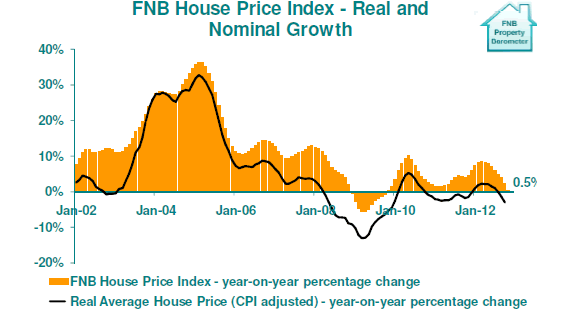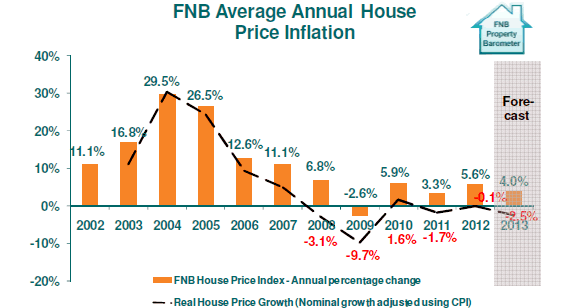House Price Index Growth Slows Further in November 2012 says FNB
 John Loos, FNB Household and Property Sector Strategist
John Loos, FNB Household and Property Sector Strategist
While the housing market, along with price growth, did experience some improvement in strength earlier 2012, the pace of improvement appears to have been tapering recently, and is reflected in slower growth in house prices.
John Loos, household and property sector strategist at FNB, said the FNB House Price Index for November 2012 showed further slowing in its year-on-year inflation rate, from a revised 2.5% in October to a lowly 0.5%. This is the 8th consecutive month of tapering growth since the relatively impressive 8.4% peak in year-on-year growth reached in March 2012. The average value of homes transacted in the FNB House Price Index was R819,733 in November.
This slowing year-on-year house price growth, to levels back below consumer price inflation, implies a return to declining house prices in inflation-adjusted real terms. As at October (November consumer price inflation data not yet available), the combination of a CPI inflation rate of 5.6% year-on-year, and a 2.5% nominal house price growth rate in that month, translated into a real year-on-year decline of -3% in the FNB House Price Index.

The return to low single-digit year-on-year house price growth does not come as too much of a surprise, although we do believe that 2013 will see year-on-year house price growth a few percentage points higher than this most recent November 2012 level.
Our Estate Agent and FNB Valuer surveys do point to a mildly stronger market today than a year ago, after some improvement earlier this year, Mr Loos said.
"However, they also suggest that the most significant improvement in residential demand came earlier in 2012 after a good economic period in Summer of 2011/2012, and much of that improvement in demand may have already been reflected in stronger year-on-year house price growth of around 8% earlier in 2012," he said.
Mr Loos said while valuers and agents have witnessed demand improving earlier in the year, they haven’t been pointing to a market that is yet realistically priced, or “under-supplied”, on a national average basis. This means that as soon as there is an absence of any new stimulus, price growth very quickly slows back to low rates.
HOW FAR HAS THE MARKET (DOWNWARD) REAL PRICE CORRECTION PROGRESSED TO DATE?
According to the FNB House Price Index, the peak of real house price levels at the end of the most recent boom was in February 2008. From that month up until October 2012, the cumulative real house price decline was -18.9%. While this appears to be a significant downward correction, the real price level remains +58% higher than July 2000, the starting month for the FNB Index and also a period early in the last house price boom. In nominal terms, since February 2008 the cumulative increase up until November 2012 was a very mild +7%, although still a massive +213.2% up on June 2000.

OUTLOOK
While the latest FNB House Price Index shows almost no price growth on a year-on-year basis, we continue to believe it possible that the declining trend in year-on-year growth in the FNB House Price Index will come to a halt very soon, being a bit “overdone” perhaps, and that price growth should settle in low single-digit territory.
However, at this stage, economic indicators make it difficult to see much improvement in housing market conditions in 2013, after having seen some improvement earlier this year to what has been a relatively “comfortable”2012 in the residential market.

Looking forward into 2013, while year-on-year price growth may pick up a little from the November low level, "We are of the expectation that overall house price growth will be a little slower in 2013 than the average for the entire 2012," says Loos. This is based on our view of the global and domestic economy, as well as on the level of household sector indebtedness.
Domestic economic growth has come under pressure of late. In the 3rd quarter, quarter-on-quarter seasonally-adjusted annualized growth in GDP (Gross Domestic Product) fell from 3.4% previous to 1.2%. Admittedly, this decline may have been exaggerated by the recent spate of industrial action, but it is also a function of a battling global economy.
Average house price growth for 2012 is projected at 5.6%, with only 2 months’ worth of data left to come. However, not only does the global and local economy remain mediocre, but more importantly for the housing market is that we have seen real disposable income growth broadly slowing, since the very strong rates of near to 6% in 2010/early-2011, down to 3.5% by the 2nd quarter of this year. We believe that it will now move in a slower range closer to weak economic growth rates, because the rapid “normalization” (growth) in the wage bill as well as investment income, off a low base after the 2008/9 recession, has all but been completed.
This in turn curbs the growth in purchasing power of households. On top of this, we have recently started to see accelerating household credit growth draw level and start to overtake nominal disposable income growth. This accelerating household credit growth is driven by very strong growth in the non-mortgage credit components, and is the cause of a resumption of an unhealthy rise in the debt-to-disposable income ratio for the household sector. Strong growth in non-mortgage credit could increasingly constraint the household sector’s ability to purchase property going forward.
Finally, we head towards 2013 with a mildly rising consumer price inflation rate, with a recent US drought exerting recent upward pressure on food prices, and rand weakness also having had some impact on higher petrol prices, Mr Loos said. Within the CPI, housing-related Municipal rates and utilities tariffs remain troublesome, and are not set to stop their strong rise soon, with Eskom preparing the next round of multi-year tariff hikes.












